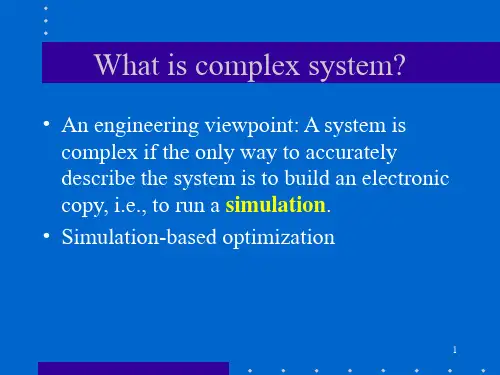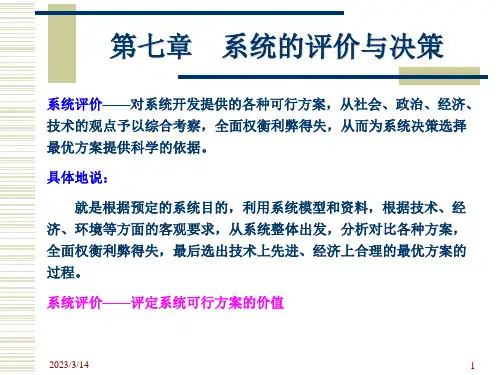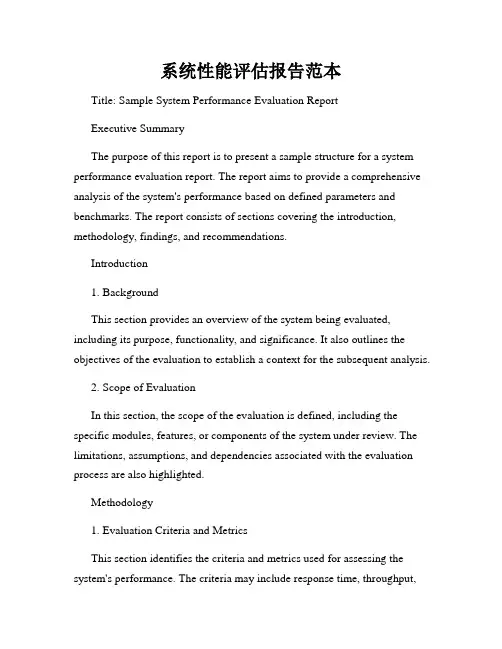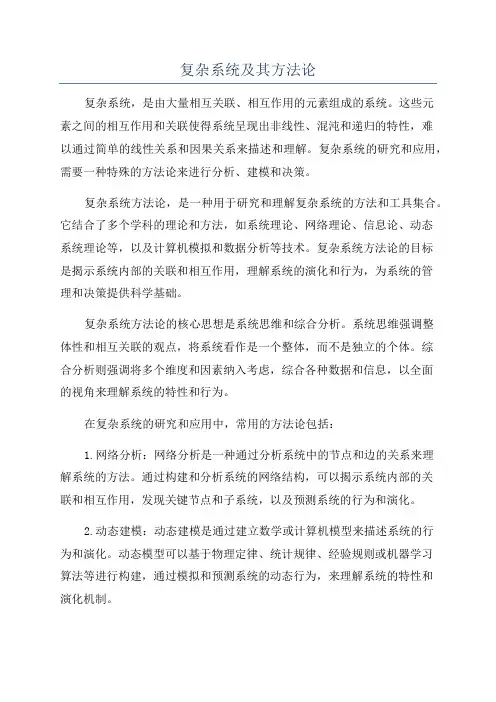(复杂系统的性能评价与优化课件资料)OverviewOfOrdinalOptimization
- 格式:ppt
- 大小:642.50 KB
- 文档页数:32


Introduction系统调优与性能评估设计分析是计算机领域中非常重要的概念和技术,它们可以帮助我们优化系统的性能,提高计算机的运行效率和响应速度。
在当今数据爆炸的时代,我们处理的数据越来越庞大和复杂,因此系统调优和性能评估设计分析变得越来越重要。
本文将介绍系统调优和性能评估设计分析的概念、方法和实践,以及其在计算机领域中的应用。
什么是系统调优?系统调优是指通过在系统的各个层面和组件上进行优化,以提高系统的性能和效率。
系统调优可以包括对操作系统、硬件、软件和网络进行优化。
通过系统调优,我们可以减少系统的延迟、提高处理和响应速度,从而提高计算机系统的整体性能。
什么是性能评估设计分析?性能评估设计分析是一种通过对系统进行测量、测试和分析,评估系统的性能和效率的方法。
性能评估的目的是发现系统在容量、吞吐量、延迟等方面的限制和瓶颈,并提出改进和优化的方案。
性能评估设计分析可以帮助我们了解系统的工作原理和性能,从而为系统调优提供指导和依据。
系统调优的方法系统调优是一种复杂而技术性强的任务,需要综合应用各种方法和技术。
下面将介绍几种常见的系统调优方法。
测量和监测测量和监测是系统调优的关键步骤之一,它可以帮助我们了解系统的当前状态和性能瓶颈。
通过测量和监测,我们可以获取系统的各种指标和度量,如延迟、吞吐量、资源利用率等。
这些数据可以用于分析系统的性能问题和优化需求。
性能剖析性能剖析是一种通过对系统的运行进行分析和调查,识别性能瓶颈和瓶颈的部分进行系统调优的方法。
通过性能剖析,我们可以找到系统中的瓶颈和效率低下的部分,并提出相应的优化方案。
性能剖析可以帮助我们深入了解系统的工作原理和性能瓶颈,从而提高系统的性能。
优化算法和数据结构优化算法和数据结构是系统调优中一个非常重要的方面。
通过优化算法和数据结构,我们可以改进系统的算法和数据结构,以提高系统的性能和效率。
例如,通过使用更高效的排序算法或数据结构,我们可以减少系统的延迟和提高处理速度。






系统性能评估报告范本Title: Sample System Performance Evaluation ReportExecutive SummaryThe purpose of this report is to present a sample structure for a system performance evaluation report. The report aims to provide a comprehensive analysis of the system's performance based on defined parameters and benchmarks. The report consists of sections covering the introduction, methodology, findings, and recommendations.Introduction1. BackgroundThis section provides an overview of the system being evaluated, including its purpose, functionality, and significance. It also outlines the objectives of the evaluation to establish a context for the subsequent analysis.2. Scope of EvaluationIn this section, the scope of the evaluation is defined, including the specific modules, features, or components of the system under review. The limitations, assumptions, and dependencies associated with the evaluation process are also highlighted.Methodology1. Evaluation Criteria and MetricsThis section identifies the criteria and metrics used for assessing the system's performance. The criteria may include response time, throughput,scalability, availability, and resource utilization. Each criterion should be clearly defined, along with the associated metrics and their respective benchmarks.2. Data CollectionThe data collection methods employed during the evaluation are outlined in this section. It includes information on the tools, techniques, or tests used to capture the required performance metrics. Any prerequisites, procedures, or special considerations for data collection should be mentioned.Findings1. Performance AnalysisThis section presents a detailed analysis of the collected performance data. The findings should be arranged based on the evaluation criteria and highlight the system's strengths and weaknesses. Any trends, patterns, or unexpected observations should be addressed. Visual aids such as graphs or charts can be utilized to enhance the presentation of the data.2. Comparison with BenchmarksThe performance metrics obtained during the evaluation are compared against the predefined benchmarks and industry standards. This section outlines the variances between the actual performance and the desired performance levels. Deviations from benchmarks are identified and explained.3. Performance Optimization RecommendationsIn this section, recommendations are provided to address the identified performance issues and optimize the system. Potential solutions and strategies should be presented, including hardware or software enhancements, configuration changes, or process improvements. Each recommendation should be supported by relevant justifications.ConclusionThe conclusion section summarizes the key findings and recommendations from the evaluation. Emphasis should be placed on the significance of the evaluation results and the potential benefits of implementing the recommendations.AppendixThe appendix may include additional supporting materials, such as raw data, test configurations, or any relevant documentation. These materials can provide further insights into the evaluation process and aid in the understanding of the report.Note: This sample report follows a general structure for system performance evaluation reports. The content and format can be modified to suit specific requirements and preferences.。



复杂系统及其方法论复杂系统,是由大量相互关联、相互作用的元素组成的系统。
这些元素之间的相互作用和关联使得系统呈现出非线性、混沌和递归的特性,难以通过简单的线性关系和因果关系来描述和理解。
复杂系统的研究和应用,需要一种特殊的方法论来进行分析、建模和决策。
复杂系统方法论,是一种用于研究和理解复杂系统的方法和工具集合。
它结合了多个学科的理论和方法,如系统理论、网络理论、信息论、动态系统理论等,以及计算机模拟和数据分析等技术。
复杂系统方法论的目标是揭示系统内部的关联和相互作用,理解系统的演化和行为,为系统的管理和决策提供科学基础。
复杂系统方法论的核心思想是系统思维和综合分析。
系统思维强调整体性和相互关联的观点,将系统看作是一个整体,而不是独立的个体。
综合分析则强调将多个维度和因素纳入考虑,综合各种数据和信息,以全面的视角来理解系统的特性和行为。
在复杂系统的研究和应用中,常用的方法论包括:1.网络分析:网络分析是一种通过分析系统中的节点和边的关系来理解系统的方法。
通过构建和分析系统的网络结构,可以揭示系统内部的关联和相互作用,发现关键节点和子系统,以及预测系统的行为和演化。
2.动态建模:动态建模是通过建立数学或计算机模型来描述系统的行为和演化。
动态模型可以基于物理定律、统计规律、经验规则或机器学习算法等进行构建,通过模拟和预测系统的动态行为,来理解系统的特性和演化机制。
3.统计分析:统计分析是一种通过对系统的实际数据和观测结果进行分析,来理解系统性质和行为的方法。
统计分析可以通过描述统计、推断统计、因果分析等方法来揭示系统的关联和相互作用,发现潜在的规律和模式,并进行可靠性评估和预测。
4.决策支持:决策支持是一种通过应用方法论和工具来帮助决策者进行决策的方法。
决策支持方法将多个因素和目标纳入考虑,分析不同决策方案的风险和效益,以及系统的稳定性和可行性,为决策提供科学依据。
综上所述,复杂系统及其方法论是一门跨学科的领域,涉及系统思维、综合分析和多种方法和工具的应用。